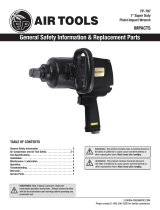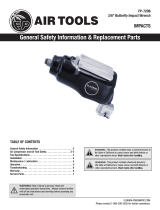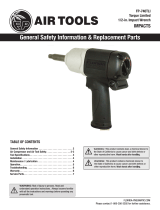Page is loading ...

7 HUSKYTOOLS.COM
Please contact 1-888-43-HUSKY for further assistance.
Operation (continued)
5
Tightening or loosening the bolt or fastener
WARNING: Once a bolt or fastener is seated, impacting for
longer than ve (5) seconds will cause excessive wear and
possible damage to the impact mechanism. If it takes longer
to tighten or loosen your bolt or fastener, we recommend the
use of a larger sized impact wrench.
□ Fit the impact socket.
□ Hold the impact wrench with one hand.
□ Ensure that the operator is aware of the torque direction to tighten
(Forward) or loosen (Reverse) and has selected the suitable torque level.
□ Use the tool to tighten or loosen the bolt or fastener.
Maintenance
Ensure the air line is shut-off and drained of air before removing this tool for service or changing sockets.
This will prevent the tool from operating if the throttle is accidentally engaged.
LUBRICATION
□ An in-line lter-regulator-lubricator is recommended as it increases tool life and keeps the tool in
sustained operation.
□ Regularly check and ll the in-line lubricator with air tool oil. Avoid using excessive amounts of oil.
□ Adjust the in-line lubricator by placing a sheet of paper next to the tool’s exhaust ports and holding the
throttle open approximately 30 seconds. The lubricator is properly set when a light stain of oil collects on
the paper.
□ If it is necessary to store the tool for an extended period of time (overnight, weekend, etc.), generously
lubricate the tool through the air inlet. Run the tool for approximately 30 seconds to ensure the oil is
evenly distributed throughout the tool. Store the tool in a clean and dry environment.
□ Recommended lubricants: Air tool oil or any other high grade turbine oil containing moisture absorbent,
rust inhibitors, metal wetting agents, and an EP (extreme pressure) additive.

8
Troubleshooting
Problem Possible Cause Solution
The tool runs slowly or will not
operate.
There is grit or gum in the tool. Flush the tool with air tool oil or gum solvent.
The tool is out of oil. Lubricate the tool according to the lubrication
instructions in this manual.
The air pressure is low. □ Adjust the regulator on the tool to the
maximum setting.
□ Adjust the compressor regulator to the tool’s
maximum setting of 90 psi.
The air hose leaks. Tighten and seal the hose ttings with pipe thread
tape if leaks are found.
The air pressure drops. □ Ensure the hose is the proper size. Long
hoses or tools using large volumes of air may
require a hose with an I.D. of ½" or larger
depending on the total length of the hose.
□ Do not use a multiple number of hoses
connected together with a quick connect
tting. This causes additional pressure drops
and reduces the tool power. Directly connect
the hoses together.
There is a worn rotor blade in the motor. Replace the rotor blade.
There is a worn ball bearing in the motor. Remove and inspect the bearing for rust, dirt, and
grit. Replace or clean and grease the bearing with
bearing grease.
There is moisture blowing out
of the tool’s exhaust.
There is water in the tank. Drain the tank. (See the air compressor manual
for instructions.) Lubricate the tool and run it until
water is not evident. Lubricate the tool again and
run for 1-2 seconds.
The tool impacts slowly or not
at all.
The tool needs lubricating. Lubricate the air motor and the impact mechanism
according to the lubrication instructions in this
manual.
The tool regulator setting is in the wrong position. Adjust the regulator on the tool to the maximum
setting.
The tool impacts rapidly, but
will not remove bolts.
The tool has a worn impact mechanism. Replace the worn impact mechanism components.
The tool does not impact. The impact mechanism is broken. Replace the broken impact mechanism
components.

9 HUSKYTOOLS.COM
Please contact 1-888-43-HUSKY for further assistance.
Service Parts

10
Service Parts (continued)
Reference
Number
Part Number Description Reference
Number
Part Number Description
1 931224801 Housing Assembly 25 9287246G O Ring
2 9160A15G Anvil Bushing 26 916038G Mufer Cover
3 931224819A Washer 27 916039G Screw (2)
4 9287159G Anvil 28 931224804 Trigger
5 9287161G Hammer Pin 29 916005G Trigger Pin
6 9287160G Hammer Case 30 916014G Spring
7 9287162G Hammer Dog 31 9106365G O Ring
8 9287163G Cam 32 916011G Air Regulator
9 9287228G Ball Bearing 33 916013G Screw
10 9287166G Front End Place 34 916007G Bushing
11 9287168G Rotor 35 916006G Valve Stem
12 9287169G Rotor Blade (6) 36 916008G Steei Ball
13 931224830 Pin 37 916009G Spring
14 910624G Cylinder 38 916010G Air Inlet
15 931224823 Pin 39 931224811 Plastic Plug
16 9287172G Rear End Plate 40 910637G Screw
17 9287228G Ball Bearing 41 910635G Pin
19 931224803 Reverse Valve 42 916036G Spring
20 9312248331 Gasket 43 9126004G Oil Plug
21 916033G End Cap 44 9481586 Rubberized HUSKY logo (2)
22 931224835 Washer (4) 45 931224801A Handle Grip
23 9287232G Cap Screw (4) 46 916043G O Ring
24 9284247G Retainer Ring
/





